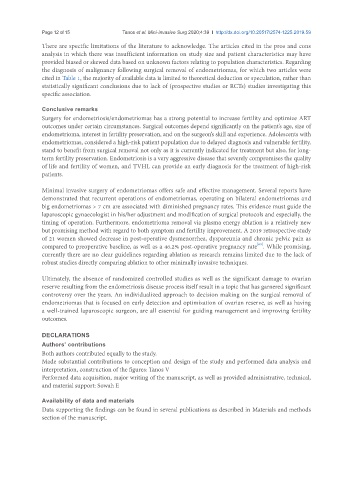Page 340 - Read Online
P. 340
Page 12 of 15 Tanos et al. Mini-invasive Surg 2020;4:39 I http://dx.doi.org/10.20517/2574-1225.2019.59
There are specific limitations of the literature to acknowledge. The articles cited in the pros and cons
analysis in which there was insufficient information on study size and patient characteristics may have
provided biased or skewed data based on unknown factors relating to population characteristics. Regarding
the diagnosis of malignancy following surgical removal of endometriomas, for which two articles were
cited in Table 1, the majority of available data is limited to theoretical deduction or speculation, rather than
statistically significant conclusions due to lack of (prospective studies or RCTs) studies investigating this
specific association.
Conclusive remarks
Surgery for endometriosis/endometriomas has a strong potential to increase fertility and optimize ART
outcomes under certain circumstances. Surgical outcomes depend significantly on the patient’s age, size of
endometrioma, interest in fertility preservation, and on the surgeon’s skill and experience. Adolescents with
endometriomas, considered a high-risk patient population due to delayed diagnosis and vulnerable fertility,
stand to benefit from surgical removal not only as it is currently indicated for treatment but also, for long-
term fertility preservation. Endometriosis is a very aggressive disease that severely compromises the quality
of life and fertility of women, and TVHL can provide an early diagnosis for the treatment of high-risk
patients.
Minimal invasive surgery of endometriomas offers safe and effective management. Several reports have
demonstrated that recurrent operations of endometriomas, operating on bilateral endometriomas and
big endometriomas > 7 cm are associated with diminished pregnancy rates. This evidence must guide the
laparoscopic gynaecologist in his/her adjustment and modification of surgical protocols and especially, the
timing of operation. Furthermore, endometrioma removal via plasma energy ablation is a relatively new
but promising method with regard to both symptom and fertility improvement. A 2019 retrospective study
of 21 women showed decrease in post-operative dysmenorrhea, dyspareunia and chronic pelvic pain as
[63]
compared to preoperative baseline, as well as a 46.2% post-operative pregnancy rate . While promising,
currently there are no clear guidelines regarding ablation as research remains limited due to the lack of
robust studies directly comparing ablation to other minimally invasive techniques.
Ultimately, the absence of randomized controlled studies as well as the significant damage to ovarian
reserve resulting from the endometriosis disease process itself result in a topic that has garnered significant
controversy over the years. An individualized approach to decision making on the surgical removal of
endometriomas that is focused on early detection and optimization of ovarian reserve, as well as having
a well-trained laparoscopic surgeon, are all essential for guiding management and improving fertility
outcomes.
DECLARATIONS
Authors’ contributions
Both authors contributed equally to the study.
Made substantial contributions to conception and design of the study and performed data analysis and
interpretation, construction of the figures: Tanos V
Performed data acquisition, major writing of the manuscript, as well as provided administrative, technical,
and material support: Sowah E
Availability of data and materials
Data supporting the findings can be found in several publications as described in Materials and methods
section of the manuscript.

